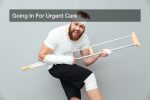
Summer is the best time for outdoor activities in the sun. In the warmer weather, though, it’s important to drink plenty of water, to be careful when doing physical activities, and to have a first aid kit and fully charged cell phone when going out. Before you take your next trip into the great outdoors, here are a few of the most common summertime injuries, accidents, and illnesses that can occur outdoors and the steps you can take to treat them.
Heat Stroke
Heat stroke occurs when we are exposed to extreme temperatures, damaging the part of the nervous system that regulates internal temperature. Heat stroke is especially serious and can be fatal, killing nearly 200 people in the United States annually, so it’s recommended that you visit an urgent care or walk in clinic if you experience dizziness, headache, fainting, or find that you’re disoriented or unable to sweat. Physicals usually won’t be necessary upon arrival, but if you suspect that you or a friend has heat stroke, it is recommended that you stay cool–especially by staying in the shade applying ice to the armpits, neck, and back.
Fractured or Broken Bones
Outdoor activities reach their peak in the summer months, but that also means that it’s easy to suffer a fall or serious impact. If you plan to spend time outdoors this summer, always bring a small first aid kit, as these will often have bandages and materials that you can use for a splint as you head to the hospital. However, you can also keep an arm fracture or twisted ankle straight by using trekking poles, tent stakes, sleeping pads, or whatever else is handy. It can be difficult to tell the difference between a sprain and a fracture when you’re outdoors, so it’s best to assume both are serious and go straight to the hospital. Your physician will want to perform one or several physicals to determine the extent of the damage and should take x-rays of the damage as well.
Poison Ivy
Campers and outdoor lovers this summer should also be wary of Poison Ivy, whose leaves, stems, and roots all cause itching, swelling, and blisters. Poison ivy rashes are rarely serious enough to warrant a visit to the doctor, but physicals may be necessary if you develop oozing blisters, if you are running a fever, or if you are having difficulty breathing from inhaling burning poison ivy. Otherwise, patients are usually able to treat poison ivy rashes themselves with cold compresses, oatmeal baths, and calamine lotion.
Hopefully you’re able to enjoy a safe summer without needing a trip to the doctor’s office. However, you should always know how to reach your local urgent care. Nearly all of them are open seven days a week, and about 80% are equipped to treat fractures and sprains. Emergencies can happen at any time, so it pays to be prepared for whatever comes your way.

